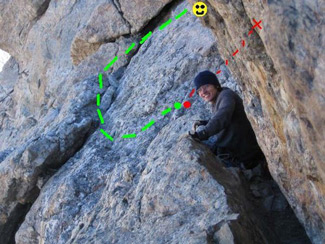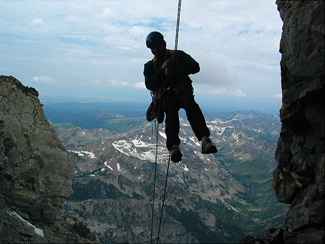
The far climber just completed the Belly Roll, possibly
the most exposure maneuver of the route.
This photo illustrates the exposure of the Owen-Spalding
route. All the climbers pictured are standing on the edge
of a 1500' cliff into Garnet Canyon. Notice how close
they are staying to that wall...

This diagram shows the easier route to the Double
Chimney after the Belly Roll.

This is the 75' free rapel on the descent of
Owen-Spalding.
This is the route used during the first ascent of the Grand. It is still the most commonly-used route today. It is also the easiest route. Technical climbing is minimal, with the exception of two very exposed pitches ranked at 5.5. Not hard, until you realize that if you fall, you fall for about 1500 feet...yikes.
Directions
From the Lower Saddle, hike north toward the obvious black dike. The trail will split in a couple of places. Stay left and end up on the left (west) side of the dike. A tall feature called The Needle will greet you just past the dike. Engage in class 3 for short distance until reaching a slight headwall and a large chockstone chimney to the right. Climb slabby terrain for 100 ft to the right until reaching a ledge. The next obstacle is the Eye-of-the-Needle, which is a tunnel-like opening in the rock. Continue through the Eye, then traverse north along a ledge until reaching a large boulder which you must climb around with a little exposure.
Head up into the couloir and follow the climber's trail to the Upper Saddle. At the Upper Saddle, the Enclosure will be to the left, and the west face of the Grand will be on the right. At the Upper Saddle, the entire west face and the bottom of the OS route will come into view. Take a minute and note features and the route. Also, look behind you and remember which of the two couloirs were used in the ascent. You will want to use the center couloir for your descent. The westerly couloir is the Idaho Express and is easily mistaken for the descent route.
From the Upper Saddle, the object is to traverse north across the bottom of the west face before ascending up to the summit block. The standard OS does the complete traverse, but there are several cracks along the way for variations of the route including the Collins-Hume (5.11) and the Wittich Crack (5.6). Climbers generally rope up before beginning the traverse. Begin the traverse with the Belly Roll pitch. This is an easy section, but you will want to be roped due to the exposure. Afterward, the Crawl Pitch is done by doing a hand traverse over fantastic exposure. The Crawl Pitch shortly ends with the Double Chimney where the upward ascent to the summit block continues. This chimney (5.5) climbs about 20 feet to a large ledge. From the ledge, look directly up and right into the obvious Owen Chimney. From here and to the extreme right (south) the OS Original Route continues along The Catwalk slabs.
The Owen Chimney (5.5) usually contains some degree of ice. Warmer years may yield less, but the right-hand side of the chimney is almost always in shade and is icy. Good pro can be found in the Owen Chimney which is approximately 80 ft. Exit the chimney on a good belay ledge with great anchor points. After exit, look for the large chimney system to the left (east). This is the Sargent's Chimney and is about 80 ft. Also, look to the right and locate the rappel station for your eventual rappel to the upper saddle. Continue up the Sargents Chimney and look for rap slings at the top. After the chimney, go left (north) and traverse along a narrow ledge and slab. At the end of slab, go right (south) until reaching the obvious class 3 blocky terrain to the summit.


